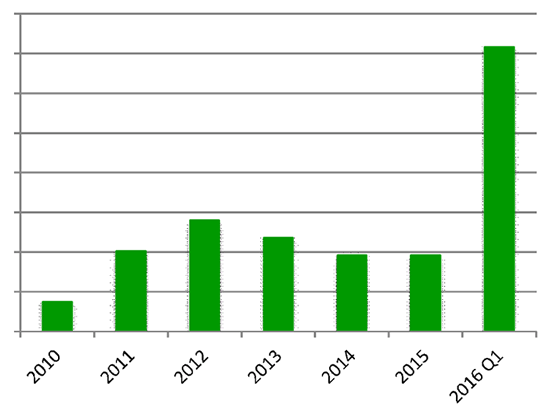Led by the Weyerhaeuser/Plum Creek merger and Potlatch’s Q2 2016 timberland divestiture in Idaho, public timberland-owning REITs purchased and divested more acres over the past year than any other type of owner. The presence of TIMOs and REITs as both buyers and sellers continues to speak to the relative maturity of the sector, as investors continue to grapple with the reality of a constrained “solution set” of opportunities. The acquisition of Potlatch’s Idaho acres by Southern Pine Plantation, based in the South, provides evidence to how regional investors continue to broaden their screening of candidate properties while operating within a relatively finite “investable universe” for timberlands.
Timberland Transactions
Timberland investors looking to acquire assets and timber REITs seeking to grow their asset bases both made big moves over the past 16 months. Firms in Forisk’s North American Timberland Owner & Manager List were among those that conducted at least 92 publicly known timberland transactions totaling over 9.8 million acres between Q1 2015 and April 2016. This includes 29 transactions over this time frame that exceeded 20,000 acres each.
The figure below highlights how timberland transaction volume over the past five years leading to 2016 rose to levels more in line with pre-Recession markets. From 2011 through 2015, large-acre, publicly announced deals averaged 2.2 million acres and 52 closings in the U.S. annually.
Timberland Transaction Volume in Acres by Year, 2010-Q1 2016

Each year seemed to have a “signature” transaction as the market probed its way forward. In 2012, Hancock Timber Resource Group and Molpus acquired 1.9 million acres from Forest Capital Partners, closing out Forest Capital’s work in transferring Boise Cascade’s timberlands to the institutional investment sector. In 2013, Weyerhaeuser acquired 645,000 acres from Longview Timber (Brookfield) in the Pacific Northwest, recapturing the acres within a public REIT that had once traded as a standalone public REIT (in 2006). In 2014, JWTR sold 600,000 acres in Oregon to Green Diamond. And 2015 opened and closed with a series of robust transactions starting with the Q1 197,000-acre sale in Oregon by Cascade Timberlands to Singapore-based Whitefish Cascades Forest Products and ending with four Q4 100,000+ acre transactions involving firms such as Lyme, Campbell Global, Hancock, and Molpus.
The primary changes since Q1 2015 center on the public REITs. While the enlarged Weyerhaeuser still accounts for a small portion of private U.S. timberlands, it is the largest owner by far in the “investable universe” of industrial and institutional quality assets in the U.S. Acquisitions, divestitures and statements by public firms highlight efforts to look forward and allocate capital in ways that optimize their portfolios and shareholders. Overall, the sector continues its efforts to optimize timberland portfolios in a mature, competitive and increasingly transparent North American market.
This content may not be used or reproduced in any manner whatsoever, in part or in whole, without written permission of LANDTHINK. Use of this content without permission is a violation of federal copyright law. The articles, posts, comments, opinions and information provided by LANDTHINK are for informational and research purposes only and DOES NOT substitute or coincide with the advice of an attorney, accountant, real estate broker or any other licensed real estate professional. LANDTHINK strongly advises visitors and readers to seek their own professional guidance and advice related to buying, investing in or selling real estate.










It is impressive to see these numbers and time and the real estate market makes its corrective course. As lending begins to increase the demand for building will begin to increase along with the demand for affordable housing. Great Article!
Weyerhaeuser’s businesses are highly dependent on the housing market activities in the U.S. This industry has been steadily improving over time, with the latest U.S. Census Bureau report revealing a 9.2% year-over-year increase in housing starts in Mar 2017.
The company aims to reap collective benefit of $40−$50 million in the Timberland segment in the quarters of 2017.
This industry is good for investment and improving steadily. Thanks for sharing.
Great article!!